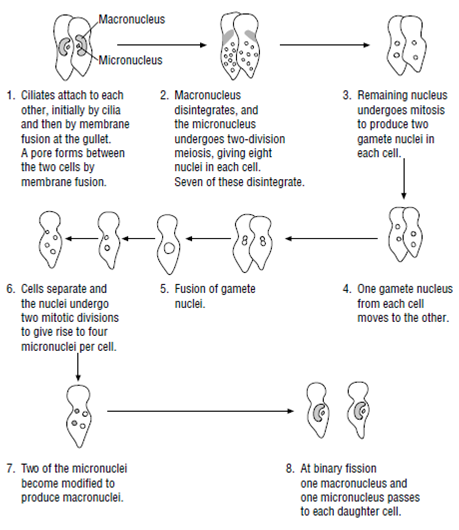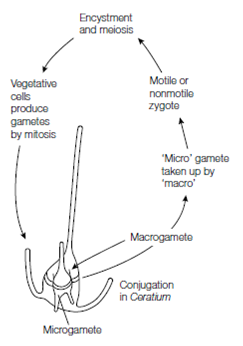Alveolates
Ciliate asexual reproduction is also by binary fission after mitosis of the nucleus. Cell division is described as homothetogenic, across the narrow part of the cell. Ciliates have two types of nuclei, a micronucleus that is diploid, contains little RNA and a lot of his- tone, and a macronucleus that is polyploid and controls day-to-day cellular activities. There may be hundreds of macronuclei in one ciliate, and up to 80 micronuclei. During asexual mitotic cell division, both of these nuclei divide to provide progeny cells with at least one copy of both nuclei. During sexual reproduction the macronucleus degenerates and the micronucleus undergoes meiosis to form gametes. Gametes fuse to form a new diploid nucleus. This new nucleus divides, one copy of the nucleus remaining as the new micronucleus, and the others differentiate to provide a new polyploid macronucleus.
This unusual state of nuclear dualism appears to confer an advantage to the ciliates by having a separate genetic store in the micronucleus, and enhances RNA synthesis by the macronucleus.

Figure: Sexual reproduction in the ciliates.
This allows them to be very adaptable to changing environmental conditions.
Dinoflagellates are haploid and have unusual chromosomes, which are condensed throughout their life cycle. The chromosomes contain very little histone. Sexual reproduction commences when motile cells differentiate to become macrogametes or micro- gametes. The gametes fuse to form a zygote. Meiosis occurs followed by the degeneration of three of the four nuclear products. A haploid, motile cell then emerges from the zygote.

Figure .Reproduction in the dinoflagellates.
Apicomplexan protists are parasites with a complex life cycle. There are both diploid and haploid phases and often two host species are infected in a life cycle. The group is char- acterized by a type of cell division that is called multiple division or schizogony. During this process, multiple divisions of haploid nuclei occur, producing many progeny. These progeny are then released into body fluids like blood where they rapidly enter new host cells and establish themselves as intracellular parasites. The malaria parasite Plasmodium is an example of an apicomplexan parasite.